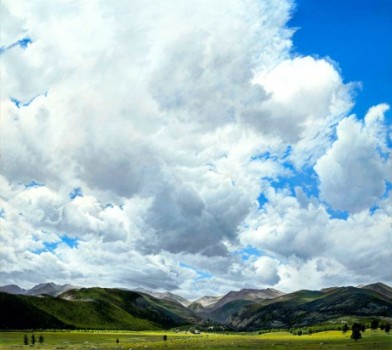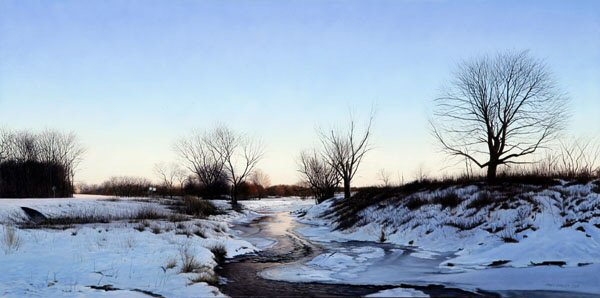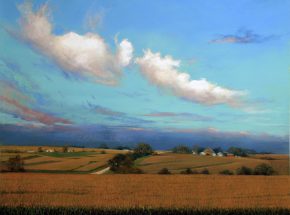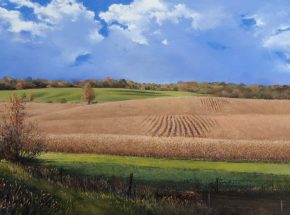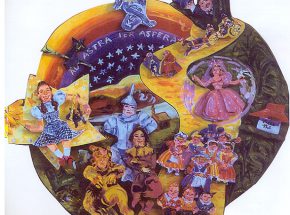
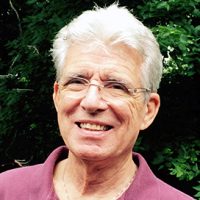
After considerable self reflective writing as part of an advanced degree and a regular forty- mile commute from my home to the university, I discovered how important the Iowa landscape is for me personally. In 1990 I began to explore the landscape as subject for new paintings, a direction I would not have predicted. While it might seem inevitable that an unabashed realist who spent many childhood summers on an Iowa farm would come to paint Iowa landscapes, I came to them only after concentrated and successful periods of work in other genres–first the figure and then still-life. For one who takes great delight in seeing and rendering the wondrous subtleties observed in faces, figures and still-life objects, the relative vastness of the landscape initially seemed daunting.
I grew up in what seems now to be the golden 50’s of the last century in Cedar Rapids, Iowa, the town where Grant Wood painted America’s most famous picture, American Gothic. His Young Corn hung in the halls of my junior high school. While initially not a particular admirer of that artist’s work, I have come to realize how much he said about Iowa and Iowans. I do feel connected to his art and the ethos of his time through the significant adults in my early life–my parents and their friends who were children of the Great Depression and who came of age during WWII. They too were of modest means, used to making do, no, making the best of what was available.
It was a small town environment, and my persona and ultimately my art was influenced by access to open spaces –the empty lot next door and the nearby “hills”, as we called them, several acres of timber and unused pasture where kids explored, built forts and felt free. And there were the summers spent enjoying and imagining in the half-used farm buildings, junk piles and open spaces which belonged to one of those depression era farmers and his wife (who could have posed for the daughter depicted in American Gothic) who were surrogate grandparents.
As I grew into adolescence and became more aware of the world outside of Iowa, mostly through the public schools and movies, it seemed that other people in other places lived a finer life than was available to me. Perhaps because I had a loving family, perhaps because the general environment embraced me and probably because I felt connected, I chose to remain here. As an artist, that does not mean that I am closed to ideas from outside the Midwest, but I believe it does require that I use the resources here and to make the best of them. That is, to make something extraordinary from something that seems quite ordinary.
Most of my paintings are based on the rural landscape within an hour drive from my home. I am connected to the area and to the places painted. I have worked to develop a personal response to this familiar environment and I continue to savor its subtle visual richness. To my mind and heart there is in this gently rolling former prairie a melodious, abstract beauty that is timeless despite man¹s intervention and it evokes a subdued and understated energy. While the paintings depict specific places, the sites are mostly chosen for how they reveal these central qualities.
Space is of great importance in my landscape paintings. To enhance it I sometimes stretch the paintings horizontally beyond practical limits. In addition, I want the observer to be drawn into that traditionally depicted space by attention to detail as well as by the intimate and painterly manner in which the images are created in order to discover and experience the visual delights which are illusive to the more casual observer.
Initially, the images were discovered and drawn mostly from the Iowa spring when the rolling hills, wet grasses, freshly plowed fields and morning light create abstract visions and thoughts of new beginnings–a time of great personal resonance.
Later I became excited by the Iowa autumn with its sometimes intense, startling colors as well as the subdued, nearly monochromatic textures of fields and roadsides revealed by warm afternoon light. I am intrigued as well by the evocative quality of roads and streams moving into unknown places.
In the the last few years I have increasingly spent more time in Northeast Iowa, a less subtle landscape bordered by the Mississippi River and with larger geological features untouched by the smoothing action of glacial drift. Few would find it banal and there is something primal about the Mississippi River itself. The great river is home to hundreds of species of wildlife and is a timeless path for waterfowl and other birds in their annual migrations. But it is perhaps also the larger sense of space in the landscape that draws me to the area. I love the eagles and barges and ever changing light on the great pools created by the lock and dam system. I feel at home there. In terms of my art I am bringing a prairie vision to a strikingly different landscape, trying to understand it and trying not to appear the tourist.
While I have been made aware of artistic possibilities based on the landscape where I live by my mid 20th century Iowa predecessors, Grant Wood and Marvin Cone, I am informed by the meditative qualities of Mark Rothko, the energy-from-within character of many of Jackson Pollock’s drip paintings, and the abstract visual stories told within a larger formal structure of the 1980’s paintings of Joseph Raphael. I have an affinity as well for Minimalism and from my still-life days, the sublime subtleties of color and structure seen in the work of Morandi. Perhaps most importantly, many 19th century paintings by the Hudson River artists and the Luminists simply just take my breath away.
I believe that the art object, no matter its physical appearance, is a metaphor for the artist. On my canvases are images of the Iowa countryside but more importantly for me, my paintings represent me in the world. They are my story. I endeavor to tell an honest one.
Fred Easker has been painting full time since 1994. Like most artists he had previously worked at other things including teacher, museum educator and director of an historic house museum which was completely renovated under his guidance.
He resides in Cedar Rapids, Iowa where he grew up and actively participates in the life of his community by working on boards and organizations involved in the arts, historic preservation and the humanities and was awarded the Friend of the Arts Award from Marion Fine Arts Council in 1993. His wife Velga who was born in Latvia is also an artist. They are currently establishing a working studio in Lansing, Iowa, a small town located in Northeast Iowa on the Mississippi River. They have one son and a new grandson who live in Denver, Colorado.
Fred Easker’s work is included in museum, corporate and private collections throughout the Midwest and has appeared in a number of periodicals and books. He was an Arts Midwest/NEA Regional Visual Arts Fellowship recipient in 1997. He was featured as an “Iowa Master” in a series produced by Iowa Public Television. Recently he completed a commissioned painting for the United States Federal Courthouse in Cedar Rapids. The artist holds a BA and MA in Art Education from the University of Iowa.
Website
http://www.easkerart.com


